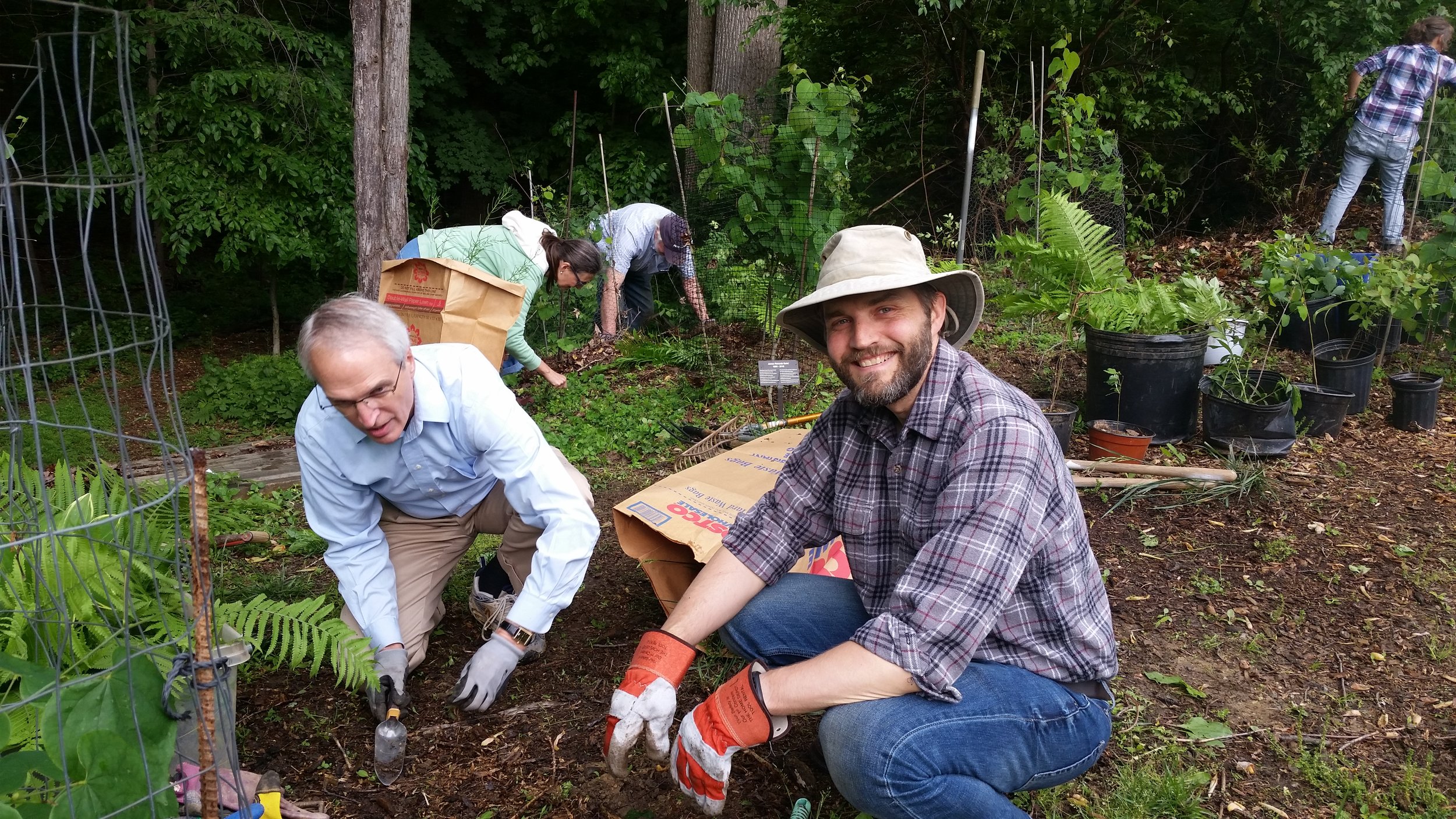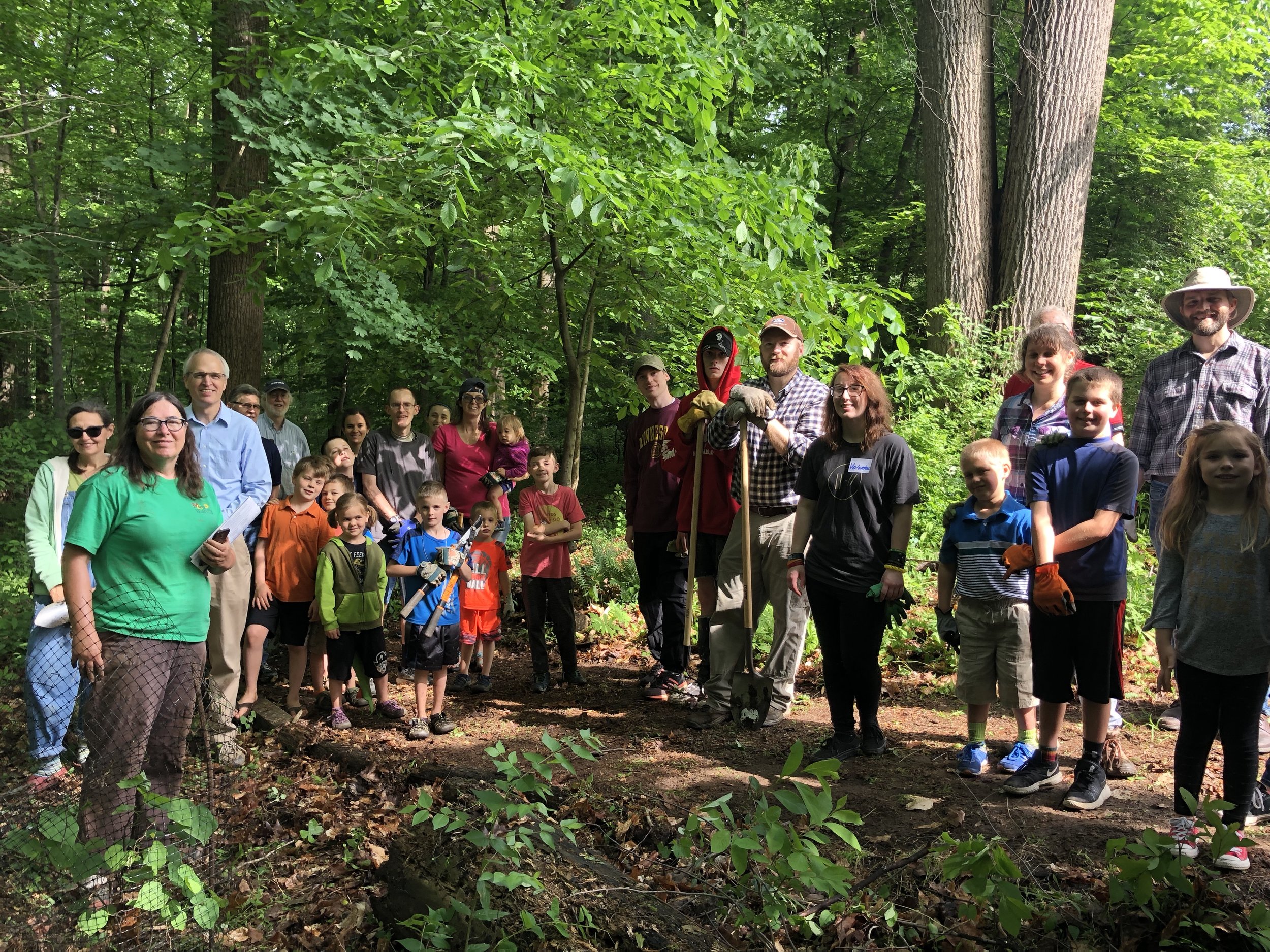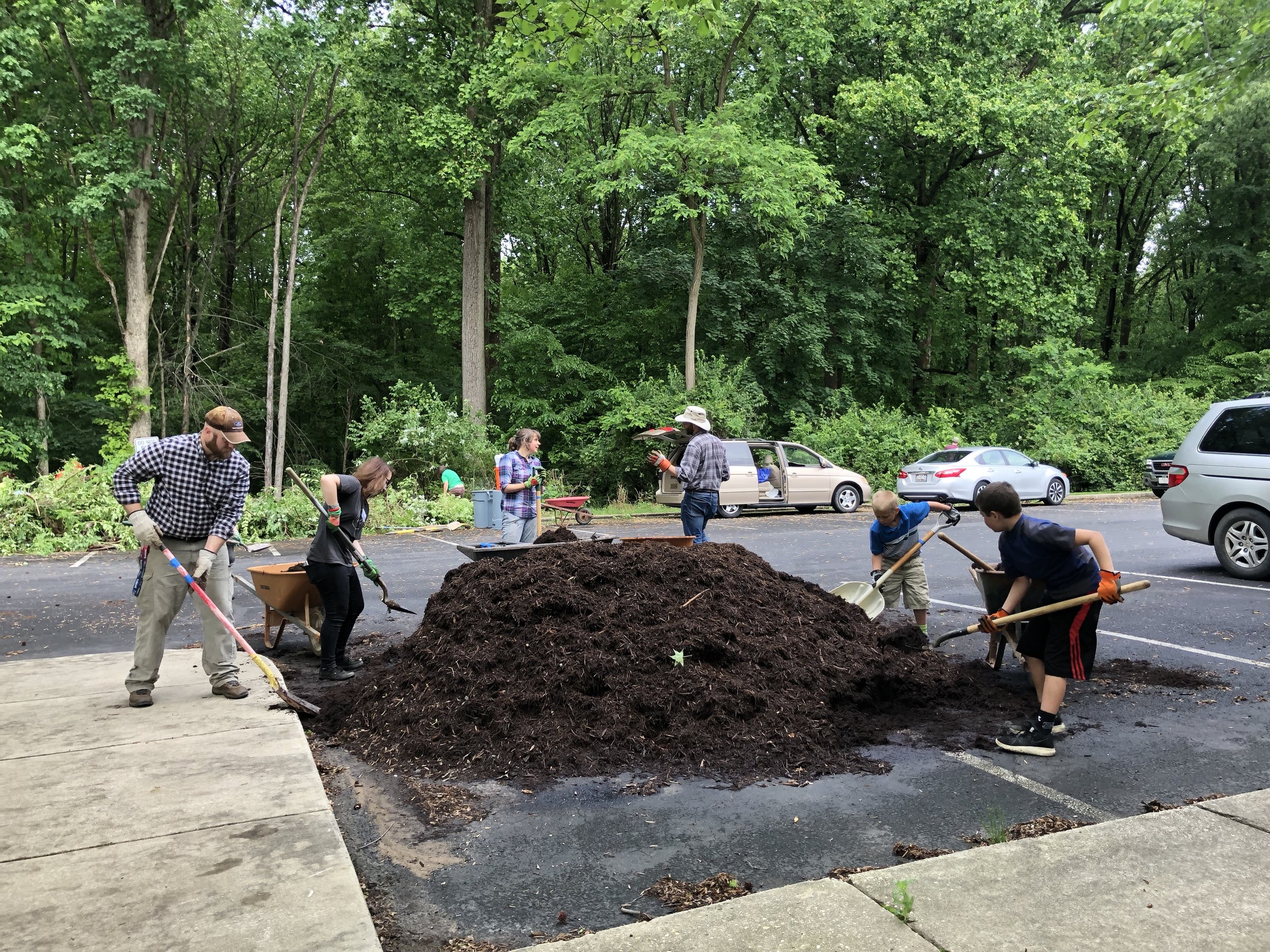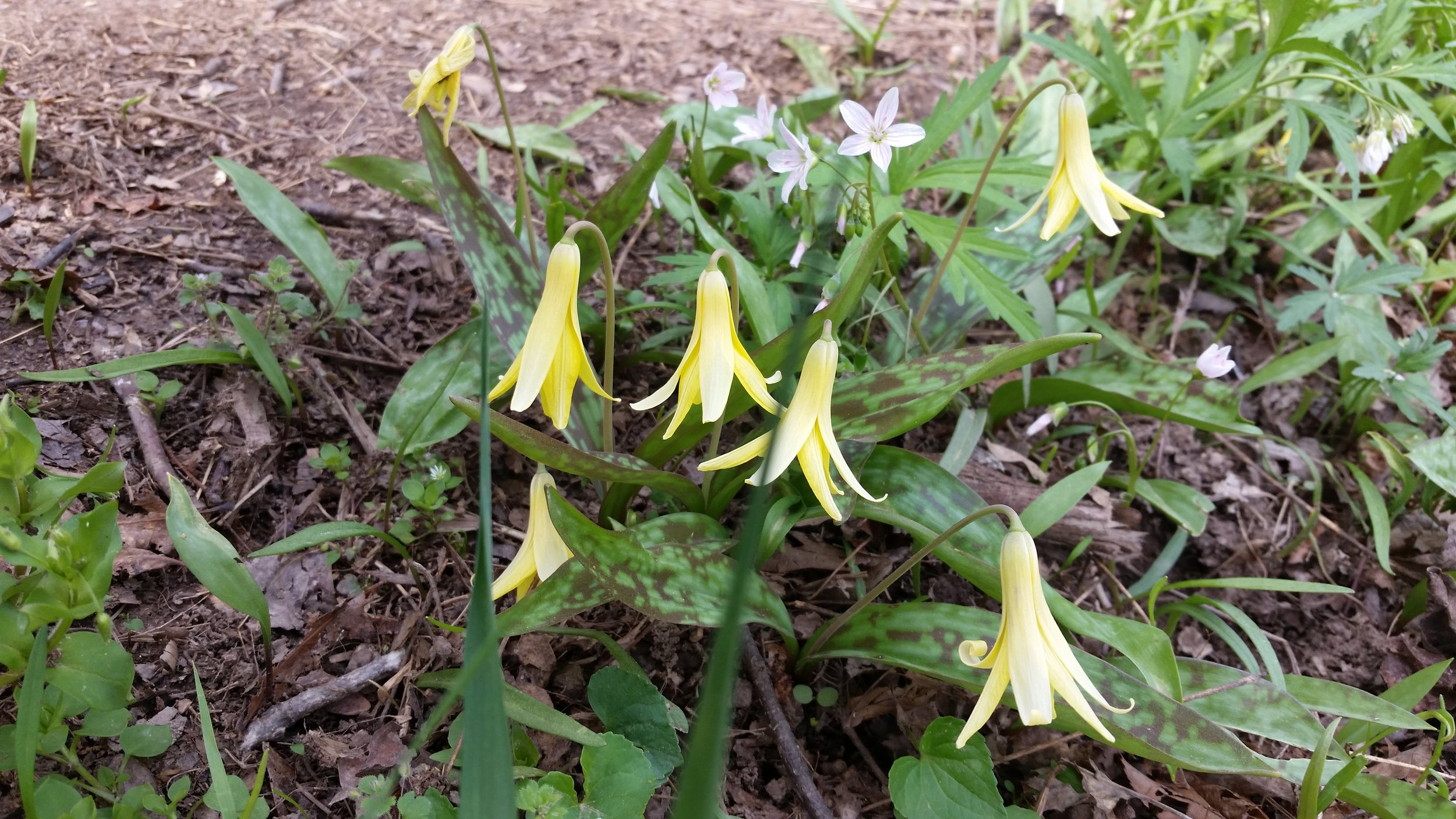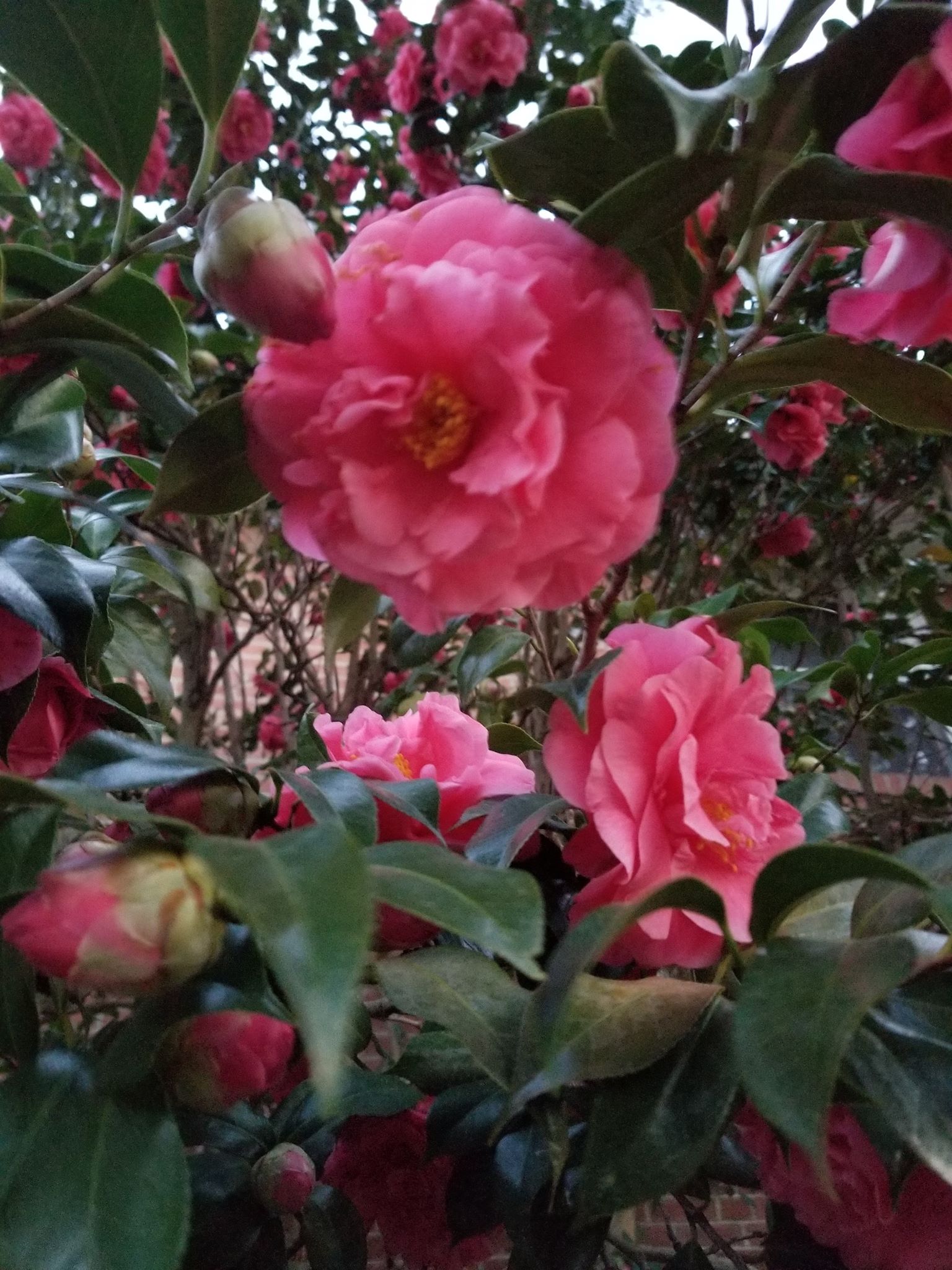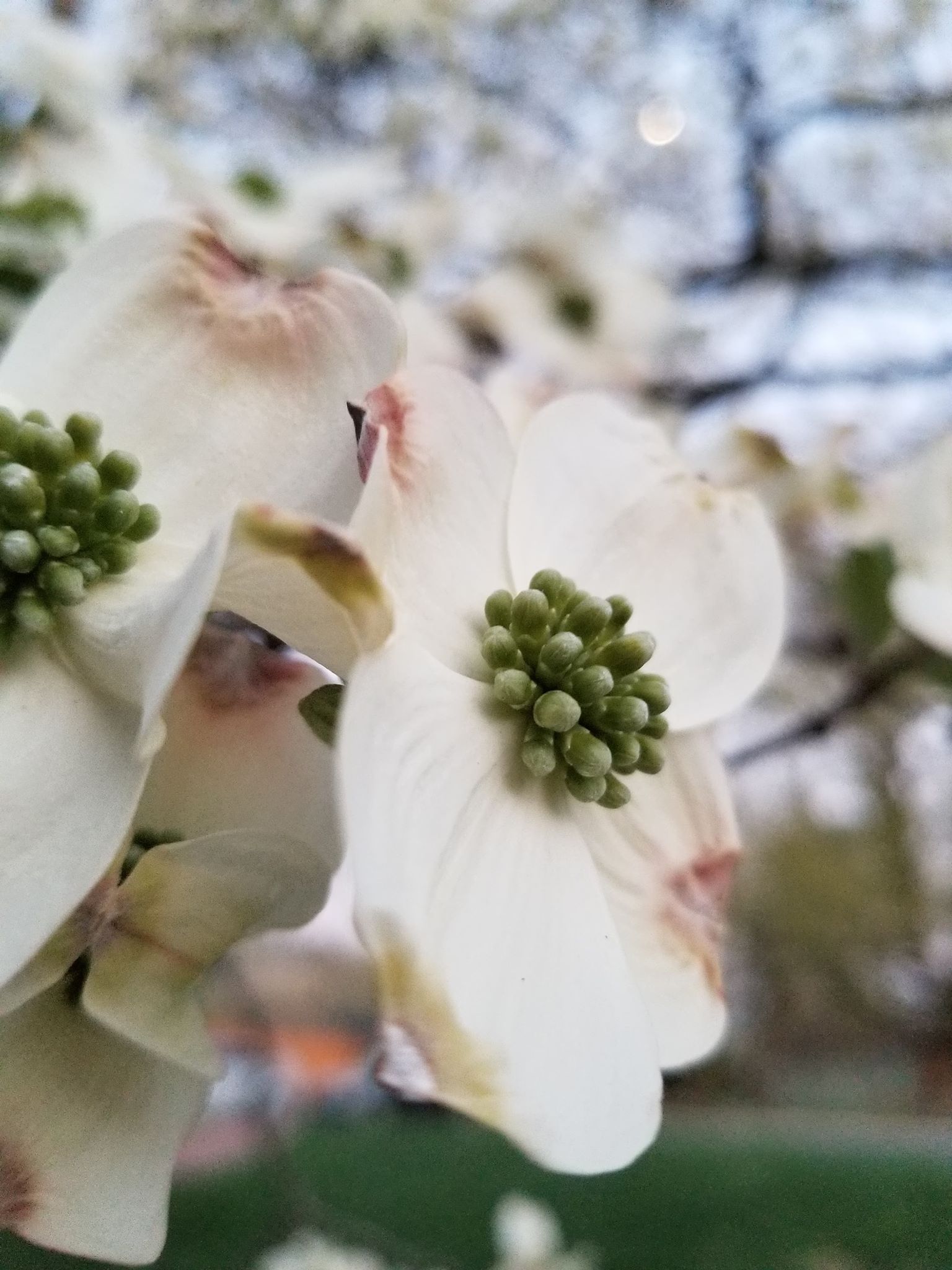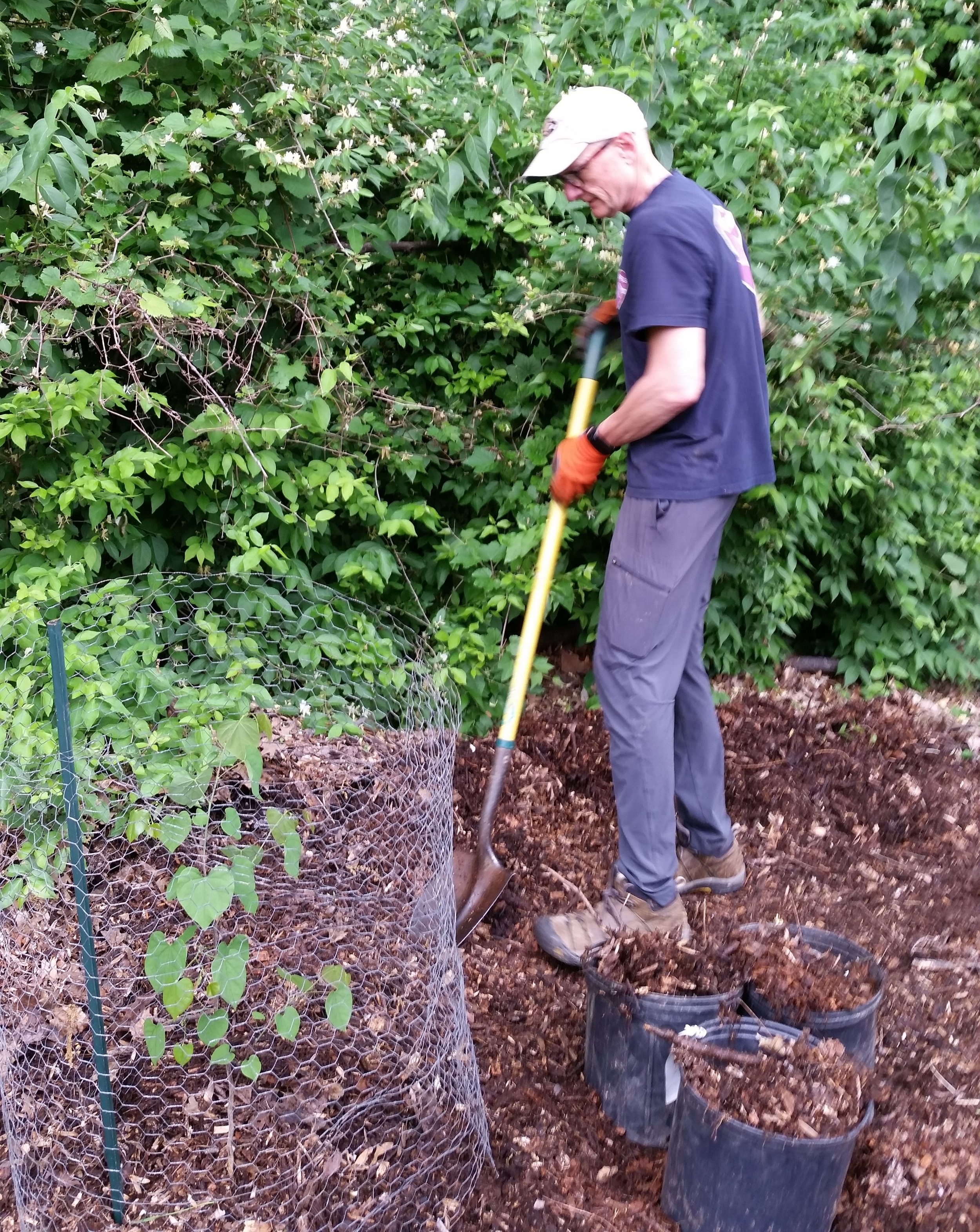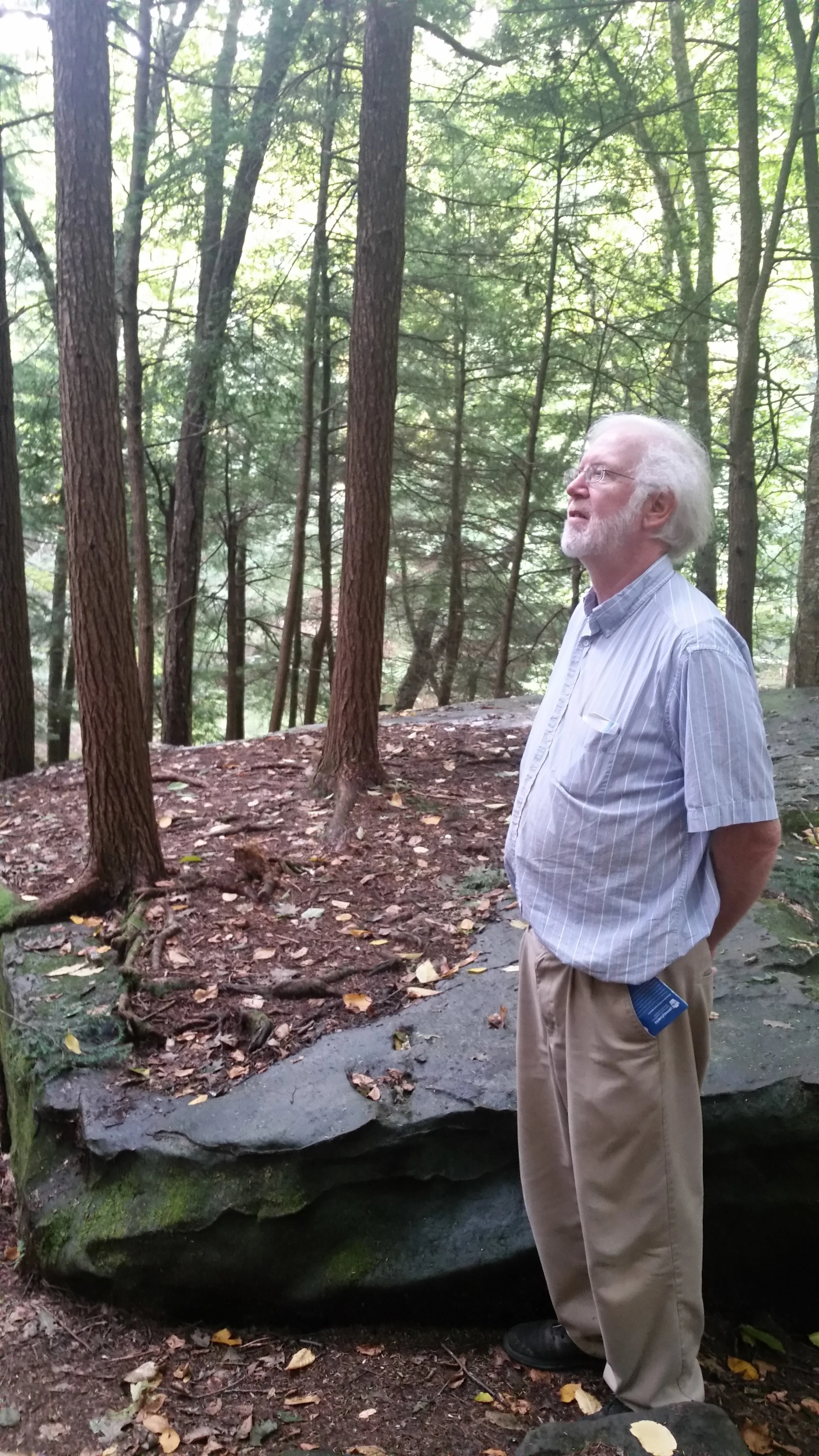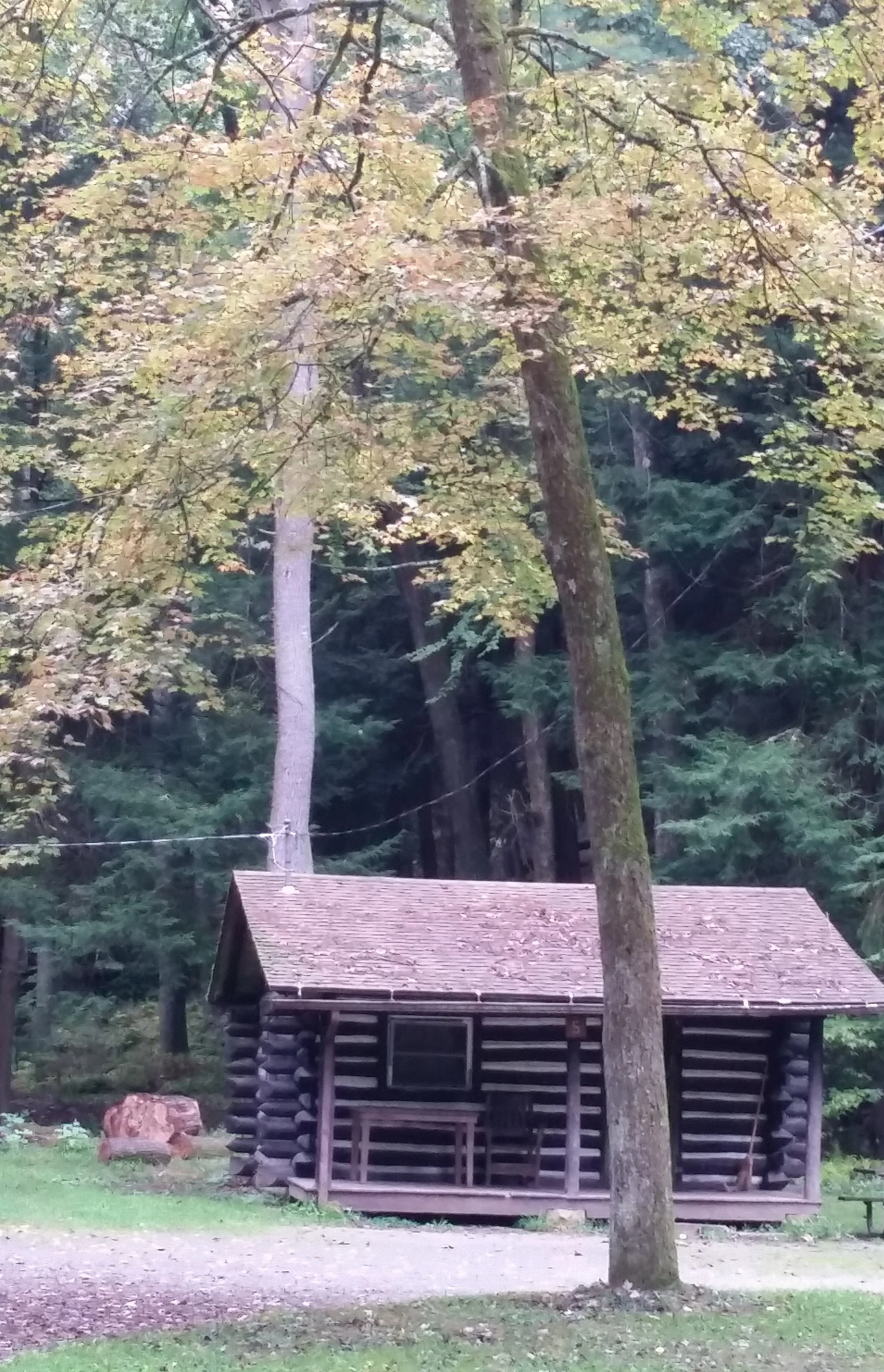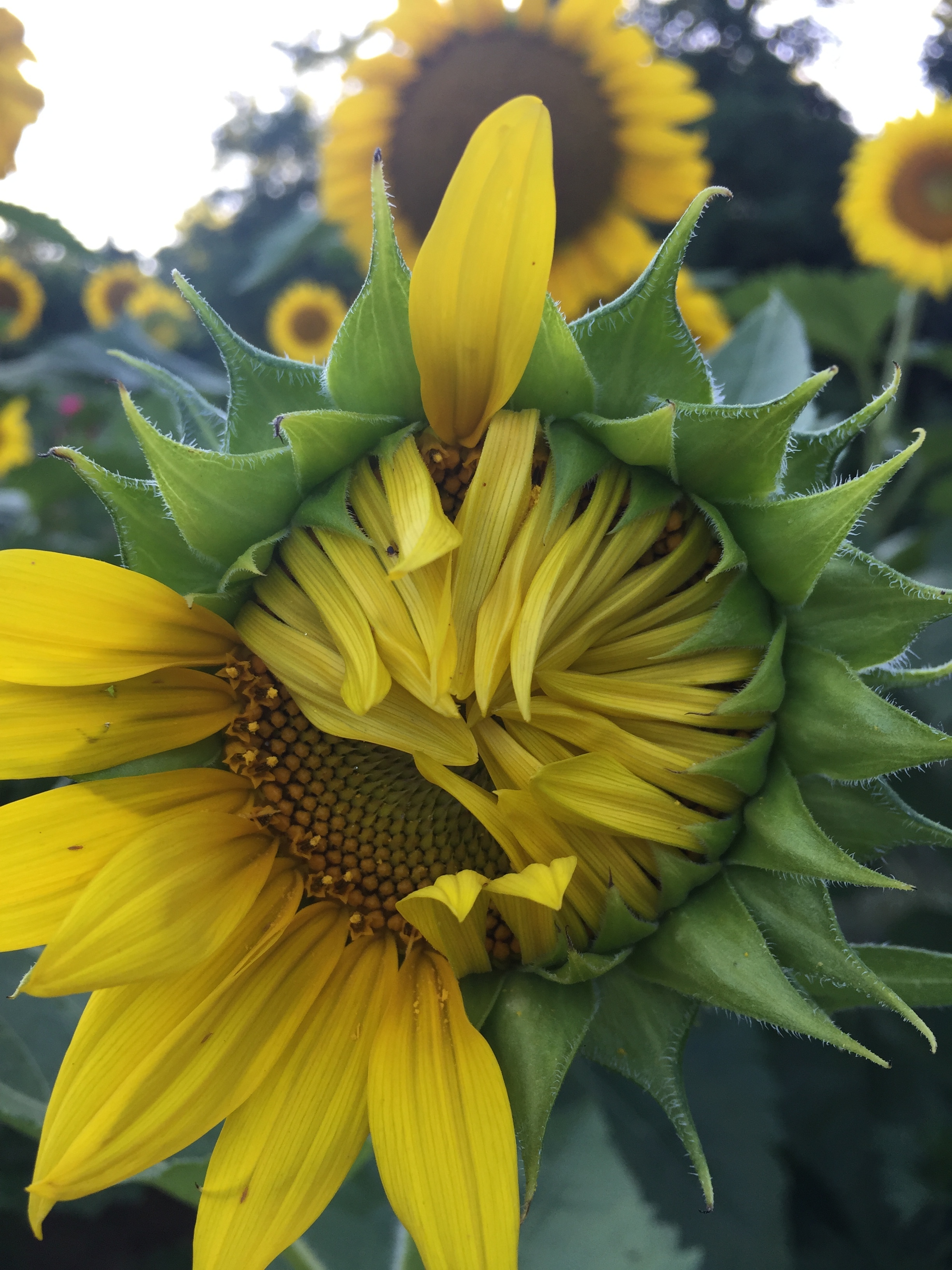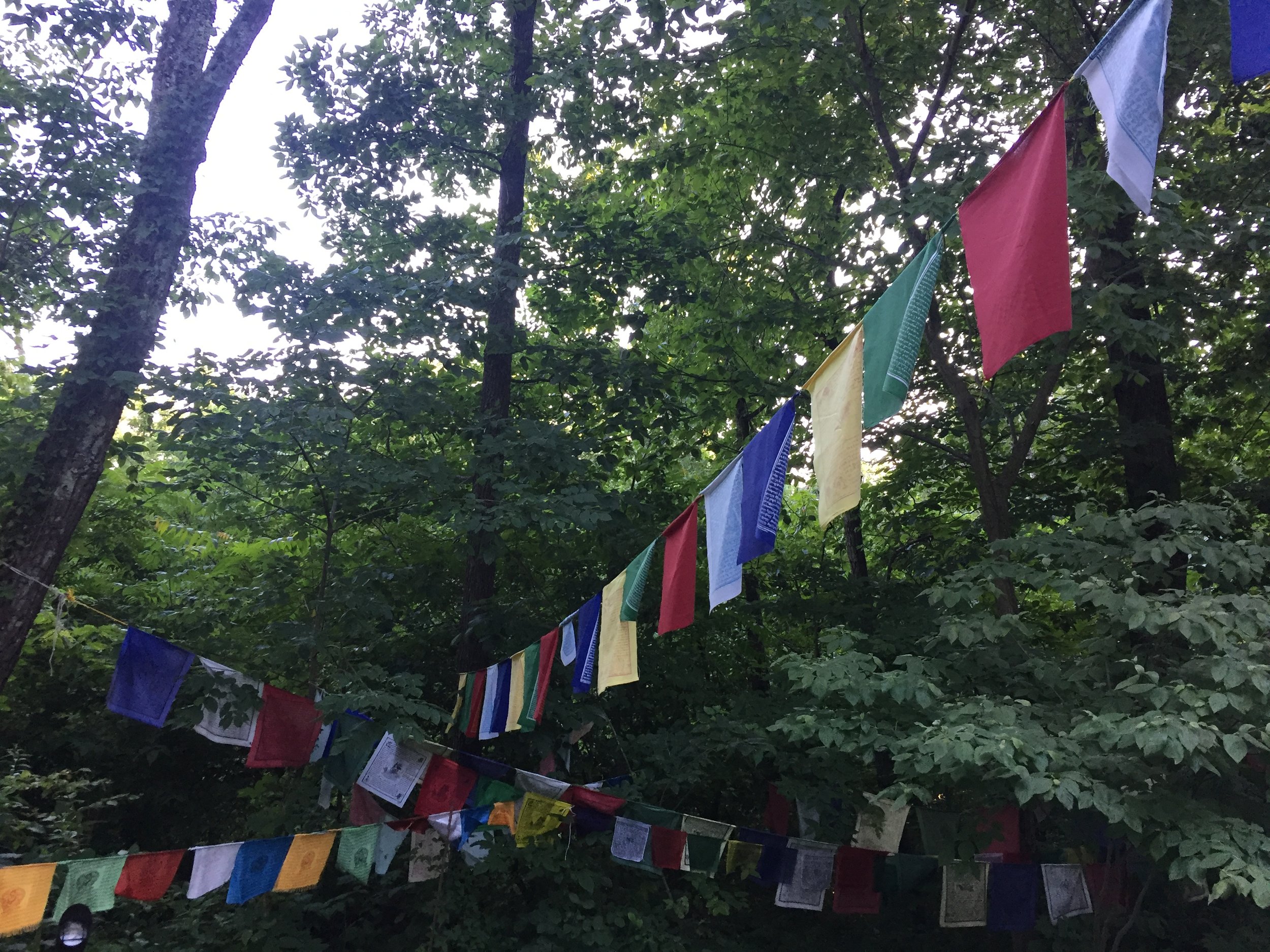Please listen to this inspired and timely presentation by BYU Humanities Professor George Handley. Given in the midst of the COVID-19 pandemic, this addresses not just our theology relative to earth stewardship but also how that relates to our current experiences of vulnerable mortality. Please share with others.
Early Spring Hike at Anglers' Inn Trail
Thanks to Terrel Hale who led our hike and walkers Merikay Smith, Sharron Barnum, Lisa Opfar, Teresa Mohr, Maura Pratt, and Erika Davis for making the time pleasantly engaging.
Besides enjoying a brisk hike on a beautifully sunny spring day, we pondered the experience of Joseph Smith 200 years ago and what the woods were like as he prayed. As we walked we saw signs of spring — trees budding, skunk cabbage emerging, migrating birds sunning on a rock in the water. We also saw more than a dozen turtles basking on logs and a skink courteously scrambled on a rock near us.
We Need a Good Blizzard!
Do you remember what it’s like when it snows? You step outside and see a few flakes gently floating down and before long, there are flakes filling the sky and the landscape is completely changed to white.
Joe Richardson says we should be like those first snowflakes as we do earth stewardship, and soon we’ll be joined by others to create a blizzard, totally altering the landscape around us. I had the pleasure of talking with Joe about how his faith and Church teachings have motivated his self-described obsession to do earth stewardship and to engage others, especially the young, in making a real difference.
Joe owns Bar-T Ranch, an extensive program of after-school care programs, summer camps and more in and around Frederick, MD. His passion for the Creation has led him to create a place where young people see earth stewardship modeled – the camp has a huge solar panel system, geothermal system, and sustainable design for the buildings including composting toilets (saving ~1M gallons of fresh water/year). He also has a 10 kilowatt wind turbine. He has recently taken 50 acres from traditional farm production to do sustainable agriculture. He has obtained funding for a massive stream restoration project on site, removing sediment, creating a wetland, creating plunge pools to slow erosion and protecting tributaries. On April 4 he’ll be hosting a Climate Solutions Symposium for high school students to meet with professional designers and engineers to learn about sustainable technologies.
Joe noticed in visiting schools the massive volume of food being wasted. Unopened cartons of milk and other food was going directly into the garbage which meant it was going to either a landfill or incinerator. In one day at an elementary school cafeteria about 60 milk cartoons and other food was trashed. He contacted nearby Frederick Rescue Mission and learned they could use this food. He started teaching the students to compost waste food, recycle other items, and set aside untouched food which is collected in a cooler and picked up daily for the Rescue Mission. In 25 days 1,517 cartons of milk and 500 apples were given to the mission. From this small start Joe has created programs in 14 schools to recycle, compost and share food – massively reducing the amount of food and other waste in the waste stream. Students are learning about composting, recycling and caring about neighbors in need. They also learn skills in keeping statistics by weighing, recording, and reporting for the project. http://www.meegreen.org/programs/school-composting-waste-reduction/
Lunch Out of Landfills is now a program being considered in even more schools across the state: Carroll, Kent, Montgomery, and Arundel counties are all starting programs. Joe will be speaking before the state legislature on March 6 about funding to extend the program statewide. There are about 12,000 students participating this year with the potential to have 3 or 4 times that many next year. There’s potential for Maryland to model the program for other states as well – dramatically increasing the amount of food saved, waste reduced and items recycled. This blizzard of earth stewardship started with the single snowflake, Joe Richardson.
https://www.youtube.com/watch?v=Y51Wh3j2wAA&feature=emb_logo
I’m so grateful to Earth Stewardship East member Caitlin Magidson who connected me with Joe. He has offered to host an event for us sometime this summer at his Bar-T ranch in Frederick. I can’t wait to see what he has created. Hope you’ll join us. Details will be posted under “Events” soon.
Happy New Year!
I was given an early gift on Christmas Eve morning when I looked out and saw a beautiful heron walking between our small ponds hunting for a fish breakfast. Hoping that you also enjoy the wonders of Creation this holiday season — and seek ways to help preserve them so future generations might experience similar wonder.
New National Marine Sanctuary on the Potomac
Anyone interested in doing a group kayaking event at the latest marine sanctuary — next summer?
An 18-square mile stretch of Maryland’s Potomac River has been designated a marine sanctuary by NOAA: Mallows Bay-Potomac River National Marine Sanctuary. It protects the remnants of 118 World War I-era wooden steamships and vessels as well as other significant maritime heritage resources.
Mallows Bay is known for its “Ghost Fleet” of more than 100 wooden steamships that were built in response to threats from World War I-era German U-boats that were sinking ships in the Atlantic. The fleet was brought to the Potomac River to be salvaged for scrap metal by a company in Alexandria, Virginia, not far from the sanctuary site. Over time the sunken ships have provided habitat for fish, nesting sites for birds, and safe haven for other wildlife.
The sanctuary was formally designated this fall prior to Armistace Day. NOAA, the State of Maryland, and Charles County will manage the national marine sanctuary jointly.
If you’re interested in an Earth Stewardship East event at Mallows Bay, contact Merikay (merikays@vrizon.net). She’ll contact local Charles County to see what earth stewardship we might do while there.
"Afire with God"
I share the following thought and photos from Rev. Mansfield Kaseman who leads the interfaith efforts for Montgomery County.
Being on our lake in the fall reminds me of Elizabeth Barrett Browning who wrote:
"Earth's crammed with heaven,
And every common bush afire with God:
But only he who sees, takes off his shoes,
The rest sit round it, and pluck blackberries."
Thanks also to Teresa Mohr for her photo of fall colors which currently provides the backdrop for our home page.
Sharon Eubank Inspires at LDSES Fall Forum
Sister Eubank serves as first counselor in the General Presidency of the Relief Society, the women’s organization (about 6 million women worldwide for The Church of Jesus Christ of Latter-day Saints) and she is also director of Latter-day Saints Charities. She knows first-hand how people are being impacted worldwide by environmental degradation. Below are my notes from her talk (posted before we had the complete text). WE NOW HAVE THE COMPLETE TEXT OF THE TALK AND IT IS POSTED UNDER ‘INSPIRATION’ on this website. Please read the full talk.
Sister Eubank spoke without notes, saying she wanted to have a conversation among colleagues. She included an extended time for Q/A and has offered to return for a discussion of questions she asked us to ponder. She spoke of the intersection of humanitarian efforts and earth stewardship.
For scriptural context Sister Eubank read from Moses 7 including the following verses (but also more): And it came to pass that Enoch looked upon the earth; and he heard a voice from the bowels thereof, saying: Wo, wo is me, the mother of men; I am pained, I am weary, because of the wickedness of my children. When shall I crest, and be cleansed from the filthiness which is gone forth out of me? When will my Creator sanctify me, that I may rest, and righteousness for a season abide upon my face? And when Enoch heard the earth mourn, he wept, and cried unto the Lord, saying: O Lord, wilt thou not have compassion upon the earth?
She shared a portion of a recent presentation she had given to the Church Presidency and Apostles on global migration and displacement. The figures are grim, with 70.8 million people forcibly displaced in 2018 alone. She spoke at length about causes for migration and the challenges facing people forced to leave their homes — and that they are not migrating simply seeking a dream of a better life but from extreme and desperate situations. As one example, 80% of the women and children fleeing South and Central America are raped in their journey to the U.S. border. They would not subject themselves to these hardships except worse conditions exist for them if they remain. War, loss of farmland, decreased production due to extreme drought or other extreme weather events, salt incursions, sea level rise and more are often the result of climate change. There is often a connection between environmental degradation and forced migrations. Sister Eubanks’s heartfelt and detailed description of the earth’s current condition included the phrase “this is what keeps me from sleeping at night”.
She made our connection clear from a simple example of not wanting to waste even a basket of raspberries. She described her anguish when she finds she’s left berries in the fridge to spoil and “they can't fulfill the measure of their creation.” This brought a chuckle from the audience but was followed by this serious warning:
“We are culpable as we waste.”
We seek Zion, to be of one heart, one mind, and to live so there are no poor. Then the earth shall rest.
As she spoke of Zion, the spiritual concept, she shared quotes and photos of Zion’s National Park — how it came to be named and artistic and literary depictions of Zion, the gorgeous Creation in Southern Utah.
Sister Eubank invited us to sing together a capella the hymn, “Guide Us O, Thou Great Jehovah”.
She asked us to consider three questions:
When we waste what others desperately need what physically happens to unity and our hearts ?
Why do we feel God in His Creations? What do others feel in our own creations?
What would move our hearts to “swell as wide as eternity”?
During the extended Q/A period Sister Eubank made it clear that her speaking to us had been approved by the Twelve and was something she enthusiastically wanted to do. She has offered to return for an informal discussion of the questions she posed — something we will certainly be doing.
A few of her comments during the Q/A:
“No question we are stewards of the earth.”
“Be creative and don’t take the morally superior ground” when trying to encourage others to earth stewardship — find ways to laugh together.
“We ARE the Church” referring to our need to take initiative to do good — and praising the efforts of LDS Earth Stewardship as an example of that.
Somewhere Over the Rainbow
Pleasant View
I stopped and took this photo on my way to the June 29, 2019 showing of a film about the history of Pleasant View and the historic African American community of Quince Orchard.
Earth Stewardship East created a native plant garden at Pleasant View which brings both beauty and life to this important historic site. Stop by to get ideas for your home landscape — feel free to pull weeds too!
I’m pleased to report that the Pleasant View Trustees are organizing the restoration of both the historic school and church at Pleasant View. Construction should begin soon.
The very small congregation which met in this historic church will be meeting in the Kentlands chapel of The Church of Jesus Christ of Latter-day Saints while this historic building is renovated. We’re grateful to the local leadership of our Church who have welcomed Mt. Olive Church led by Rev. Helen Woods to temporarily share our building. I know this is not exactly earth stewardship — but has been one among many good things that have come from our service that goes beyond “earth stewardship”.
We Wear the Workers' Seal
A crew of about 35 hard-working volunteers joined us to clear invasive shrubs/vines, pull weeds, plant native shrubs, ferns and perennials and move a mountain of mulch. All as part of a memorial tribute to James Baird our former Stake President who passed away last year from carbon monoxide poisoning. In one of his talks I remember his reference to the hymn “Put Your Shoulder to the Wheel” and how much he loved physical labor. He also loved nature and with his ward youth built a trail into the woods. We are creating a native plant garden at the entrance to these woods. We were honored to have members of the Baird family join us — this despite having a tragic loss again in their family, this time of a son (brother, uncle) Andrew James Baird, whose funeral will be this Monday. Our love and prayers go with the family and we hope that when they visit this area of the DC Stake Center they remember our affection and appreciation for James and for their family.
Spring Ephemerals and Other Joys
“Those who contemplate the beauty of the earth find reserves of strength that will ensure as long as life lasts. There is something infinitely healing in the repeated refrains of nature - the assurance that dawn comes after night, and spring after winter." Rachel Carson (link to searchable LDSES database)
Splish, splash; grackle, crackle. Spring by Terri Pitts
We have such beautiful springs in the mid-Atlantic. What’s your favorite aspect of spring? A warm breeze, swelling buds on trees, new leaves unfurling, the sound of frogs, returning migratory birds, subtle beauty of spring ephemerals or the showy non-native cherry blooms? Here’s a collage of some favorites. (Feel free to send me a photo of your favorite spring sights — merikays@verizon.net.)
All photos above are by Merikay Smith except chickadee which was taken by Doug Tallamy.
Bloodroot (Sanguineria canadensis), basking turtles at Brookside Gardens, unfurling ostrich ferns (Matteuccia struthiopteris), American toads, weeping redbud (Cercis canadensis), Virginia bluebells (Mertensia virginica), jack-in-the-pulpit (Arisaema triphyllum), white native flower whose name I don’t yet know, spring woods, trout lily (Erythronium americanum), miniature flower found on Seneca Greenway trail, chickadee.
Jared Meek of NY sends this note: These were the first Crocus flowers that I saw this spring. Even though they’re not native to the eastern U.S., they are wonderful reminder of the beautiful season to come, and a good way to get everyday citizens excited about the botanical beauty around them.
Julie Savage enjoys walks in her neighborhood (weeping cherry, dogwood and tulips; lenten rose).
Photos below of native blooms from Lauren Hubbard taken near White’s Ferry. Red trillium. cutleaf toothwort, Dutchman’s breeches, and Virginia bluebells.
Most famous of all for our area in spring are the Japanese cherry blossoms. Natalie Malkowski Reineke shares photos from DC as well as another Asian beauty, camellia, which is frequently grown in our area for it’s lovely late winter/early spring blooms. Though these are lovely, being of Asian origin they do not have the habitat value of native plants which co-evolved with native insects and other animals. So I’m happy that Natalie has also included our beautiful native dogwood which is now (mid-April) beginning to bloom.
Happy Spring!
Photo taken by a friend of Teresa Mohr and shared with her permission.
Here’s hoping you’re having a wonderful spring and are reminded with spring’s renewal of life, of the gift of our Savior’s love commemorated at this Easter season.
Free Native Trees
Merikay will have another 300 native trees to give away -- up to 10 trees per household. Trees will be available Wednesday, April 3 at 3:30 pm — 7 pm on a first-come basis.
Since trees are bare root, they must be planted soon after being picked up -- ideally that day. I generally receive 50 each of seven different tree species from the Maryland DNR. These are the trees requested for this spring: 50 buttonbush, 50 baldcypress, 50 river birch, 50 loblolly pine, 50 gray dogwood (not available), 50 serviceberry, 50 white oak.
This year Bonnie Bell will distribute 100 of the tree seedlings from Seneca State Park (office) for those who live closer to that than to Merikay's home at 14909 Spring Meadows Drive, Darnestown. Bonnie will be distributing trees from about 2:30 to 5:30 pm on Wednesday. We give all the trees away in one or two days to optimize their being successfully transplanted. Remaining trees will be given away on Thursday from 6 to 7 pm at Merikay’s home.
If you do not live near Merikay, there are programs in other counties and states to promote planting native trees. Check for programs in your area. If there isn’t one, consider starting something.
Photo is of a redbud tree from the 2018 DNR trees, planted at the DC Stake Center.
New Year of the Trees, Tu B'shvat Shabbat
Tree of Life image by Emilio Kuffer
On Saturday I visited Shaare Torah for Tu B’shvat Shabbat, a Jewish holiday which celebrates the "New Year of the Trees." Celebrating in gratitude the gift of trees feels very natural for me.
Trees are particularly meaningful for those of the Jewish faith. The phrase “tree of life,” etz chaim, is a common one in Jewish life and often refers to the Torah. It is a popular name for synagogues and Jewish schools as well as the title of one of the major works of Jewish mysticism.
With Jews we share a belief in the biblical story of the Garden of Eden where the tree of life and the tree of knowledge of good and evil grow until Adam and Eve make a choice to eat of the forbidden fruit and in the process must leave Eden but will know good from evil, life and death.
The tree of life as a metaphor for the Torah comes from the Book of Proverbs, which uses the term three times, most famously in Proverbs 3:18: Etz chaim hee l’machazikim bah (“She is a tree of life to those who grasp her”).
A special guest to celebrate Tu B’shvat, Rabbi Nina Beth Cardin, gave an extended sermon as part of the worship service. The following is only a seedling to the full tree of her remarks. Rabbi Cardin kindly sent me notes from her discourse which I’m sharing.
Rabbi Cardin began by stating that each generation has a significant work to do. As Thomas Berry has said, there is no doubt that saving the earth – the climate and the environment – is our generation’s great work.
The story from Ecclesiastes (Kohelet) Rabbah says:
When the Blessed Holy One created the first human, He took him and led him round all the trees of the Garden of Eden and said to him: “Look at My works, how beautiful and praiseworthy they are! And all that I have created is here for you. Pay attention that you do not corrupt and destroy My world: if you corrupt it, there is no one to repair it after you.
Rabbi Cardin then explored the meaning of the text from Deuteronomy 20:19
A. כִּֽי־תָצ֣וּר אֶל־עִיר֩ יָמִ֨ים רַבִּ֜ים לְֽהִלָּחֵ֧ם עָלֶ֣יהָ לְתָפְשָׂ֗הּ לֹֽא־תַשְׁחִ֤ית אֶת־עֵצָהּ֙ לִנְדֹּ֤חַ עָלָיו֙ גַּרְזֶ֔ן כִּ֚י מִמֶּ֣נּוּ תֹאכֵ֔ל וְאֹת֖וֹ לֹ֣א תִכְרֹ֑ת כִּ֤י הָֽאָדָם֙ עֵ֣ץ הַשָּׂדֶ֔ה לָבֹ֥א מִפָּנֶ֖יךָ בַּמָּצֽוֹר׃
When - in your war against a city - you besiege it a long time so that you might capture it, you must not destroy its trees, wielding the ax against them. For you eat of them, so you must not cut them down. Are trees of the field human to withdraw before you into the besieged city?
· Lo tashkhit – do not destroy
Samson Raphael Hirsh writes: “The root of the verb is the concept of corruption, not just destruction”.
Meaning: this wrong action of destruction/corruption is the upheaval of a condition of goodness, rightness, health and its expected impending progress.
It is changing something’s destiny, robbing it of the possibilities it had to thrive and prosper. And all that would have flowed from that. No act of destruction is a single act. It has consequences for – and has destroyed - all that would have come to be from it.
Only destruction that leads to construction, to more life and goodness than would have been possible without that act, is permissible.
And why, Hirsch asks, are we not to cut down this particular kind of tree:
· For from it you eat! Not just food. Trees give us:
o Soil, air, shade, water management, carbon uptake, heat management, timber, recreation, comfort, refuge and more
But how should we read the confusing last words of the verse:
· Are they a statement? a question?
· Which is the subject (tree or man) and which the predicate? Who is like whom and how?
Most commentators read it as a Q with trees being the subject:
“Are trees of the field human to withdraw before you into the besieged city?”
And the answer is no. They are defenseless, why hurt them. Even more – they help you.
Everett Fox too reads it as a question with trees as subject but with a different twist: “Are trees of the field human: can they come against you in siege?”
The answer here too is no. They are not dangerous. Why hurt them?
BUT Tzror ha mor Abraham Saba (1440–1508), a mystic and kabbalist sees something deeper
He reads this as a statement, with “human” as the subject, saying: “Yes, a human is like a tree !”
“A human,” he writes, “is a tree of the field”. You may not destroy a tree - why? - for human life depends upon it. For you eat from it. That is, trees give us our lives; we are made of trees. Not only can you not cut it down entirely, you can’t even cut off the branches for the fruit is from the branches.
And if A =B (a human is like a tree) then too B=A: (tree is like a human)
Which brings Tzror Ha-Mor to an astonishing statement:
“You may not uproot or otherwise destroy the tree at all – the reason being that the tree is like a man. That is, just as a man has a soul that feels, so a tree has a nefesh tzomahat, a soul that blooms, blossoms, grows and feels. And the sages have taught this [that is, Tzror Ha-mor argues he is not the author of this idea], for they say: ‘When a tree is cut down, her cry is heard from one end of the world to the other.’”
I came home inspired only to be welcomed by the sound of tree saws and a trunk grinder at work felling a dozen massive oak trees on the property across from our home. I would have stopped them if I could. It is devastating to think of the lost habitat, particularly since it will take another 50+ years to replace these trees. We must do better in helping those around us see the value in trees: they clean our water, produce oxygen and sequester carbon, moderate our weather, give us shade, produce food and provide habitat for many, many creatures, prevent flooding, create healthy soils, and more. Trees are crying; so am I.
The Moral Imperative of Environmental Stewardship
In a talk by Elder Steven Snow of the Church of Jesus Christ of Latter-day Saints we’re reminded of the moral imperative for our earth stewardship. See excerpts below. I hope you take time to read the entire talk:
I believe the beauty of the earth testifies of a divine creator. The founder of our Church, Joseph Smith, said as much in 1832 when he described his own search for God during his early teenage years. He wrote: “I looked upon the sun, the glorious luminary of the earth, and also the moon, rolling in their majesty through the heavens, and also the stars shining in their courses and the earth also upon which I stood, and the beasts of the field and the fowls of heaven and the fish of the waters, and also man walking forth upon the face of the earth in majesty, and in the strength of beauty whose power and intelligence in governing the things which are so exceedingly great and marvelous. . . . And when I considered upon these things, my heart exclaimed, ‘Well hath the wise man said, it is a fool that saith in his heart there is no God.’ My heart exclaimed, ‘All these bear testimony and bespeak an omnipotent and omnipresent power, a being who maketh laws and decreeth and bindeth all things in their bounds.’”[2] Joseph Smith, we believe, found God in nature—both literally on his knees in a grove of trees and in a figurative sense while contemplating the Lord’s creations. Indeed, our religion and our environment are fundamentally interconnected.
One of our Church leaders, President Dallin H. Oaks, shared some of these same concerns in an address in February of last year. He said: “These are challenging times, filled with big worries: wars and rumors of wars, possible epidemics of infectious diseases, droughts, floods, and global warming. Seacoast cities are concerned with the rising level of the ocean, which will bring ocean tides to their doorsteps or over their thresholds. Global warming is also affecting agriculture and wildlife.”[3] As one commentary on MormonNewsroom.org says, “The earth is vulnerable. . . . Excessive consumption sullies God’s seas; wanton waste blackens His air. The creation groans under the weight of recklessness and indulgence that neglects both the poor earth and the earth’s poor.”[4] Climate change is real, and it’s our responsibility as stewards to do what we can to limit the damage done to God’s creation."
As Latter-day Saints we tend to focus on our ecclesiastical and family stewardships, which is well and good. But I believe we will also be held accountable for how we treat one another, the community in which we live, and the land that surrounds us, even the earth itself. That stewardship has never been more urgent. Our generation, more than any other, has the ability to irretrievably change the land. Financial rewards provide tremendous pressure to unleash our technology to reinvent our surroundings. There will be growth; change will come. But failure to care for the land on which we live means turning our backs on the heritage laid down carefully and at such great cost by our forefathers—and will leave us immeasurably poorer.
Disappearing Insects and Why We Should Care
The article below appeared Dec. 2, 2018, on Page 41 of the Sunday Magazine, The New York Times. I have shortened it and added bold highlights. As we care for Creation we show that we care for our Creator. Spend a few minutes reflecting on what our world will be like as more insects disappear — and what you can do to protect their habitat and our climate.
The Insect Apocalypse Is Here
What does it mean for the rest of life on Earth?
By Brooke Jarvis
Sune Boye Riis was on a bike ride with his youngest son, when it suddenly occurred to him that something was missing. It was summer. He was out in the country, moving fast. But strangely, he wasn’t eating any bugs.
Riis watched his son, flying through the beautiful day, not eating bugs, and was struck by the melancholy thought that his son’s childhood would lack this particular bug-eating experience of his own.
Riis had not been able to stop thinking about the missing bugs. Insects are the vital pollinators and recyclers of ecosystems and the base of food webs everywhere. Riis was not alone in noticing their decline. In the United States, scientists recently found the population of monarch butterflies fell by 90 percent in the last 20 years, a loss of 900 million individuals; the rusty-patched bumblebee, which once lived in 28 states, dropped by 87 percent over the same period. Still, the most disquieting thing wasn’t the disappearance of certain species of insects; it was the deeper worry, shared by Riis and many others, that a whole insect world might be quietly going missing, a loss of abundance that could alter the planet in unknowable ways.
Because insects are legion, inconspicuous and hard to meaningfully track, the fear that there might be far fewer than before was more felt than documented. The feeling was so common that entomologists developed a shorthand for it, named for the way many people first began to notice that they weren’t seeing as many bugs. They called it the windshield phenomenon.
To test what had been primarily a loose suspicion of wrongness, Riis and 200 other Danes were spending the month of June roaming their country’s back roads in their outfitted cars. They were part of a study conducted by the Natural History Museum of Denmark, a joint effort of the University of Copenhagen, Aarhus University and North Carolina State University. The nets would stand in for windshields as Riis and the other volunteers drove through various habitats — urban areas, forests, agricultural tracts, uncultivated open land and wetlands — hoping to quantify the disorienting sense that, as one of the study’s designers put it, “something from the past is missing from the present.”
When the investigators began planning the study in 2016, they weren’t sure if anyone would sign up. But by the time the nets were ready, a paper by an obscure German entomological society had brought the problem of insect decline into sharp focus. The German study found that, measured simply by weight, the overall abundance of flying insects in German nature reserves had decreased by 75 percent over just 27 years. If you looked at midsummer population peaks, the drop was 82 percent.
Riis learned about the study from a group of his students in one of their class projects. They must have made some kind of mistake in their citation, he thought. But they hadn’t. The study would quickly become, according to the website Altmetric, the sixth-most-discussed scientific paper of 2017.
How could something as fundamental as the bugs in the sky just disappear? And what would become of the world without them?
A 1995 study, by Peter H. Kahn and Batya Friedman, of the way some children in Houston experienced pollution summed up our blindness this way: “With each generation, the amount of environmental degradation increases, but each generation takes that amount as the norm.” In decades of photos of fishermen holding up their catch in the Florida Keys, the marine biologist Loren McClenachan found a perfect illustration of this phenomenon, which is often called “shifting baseline syndrome.” The fish got smaller and smaller, but the smiles on the fishermen’s faces stayed the same size. The world never feels fallen, because we grow accustomed to the fall.
By one measure, bugs are the wildlife we know best: spiders in the shower, ants at the picnic, ticks buried in the skin. In another sense, though, they are mysteries, a reminder of how little we know about what’s happening in the world around us.
We’ve named and described a million species of insects, a stupefying array of families of bugs that most of us can’t even name. There are 12,000 types of ants, nearly 20,000 varieties of bees, almost 400,000 species of beetles, so many that the geneticist J.B.S. Haldane reportedly quipped that God must have an inordinate fondness for them. A bit of healthy soil a foot square and two inches deep might easily be home to 200 unique species of mites, each, presumably, with a subtly different job to do. And yet entomologists estimate that all this amazing, absurd and understudied variety represents perhaps only 20 percent of the actual diversity of insects on our planet — that there are millions and millions of species entirely unknown to science.
With so much abundance, it very likely never occurred to most entomologists of the past that their multitudinous subjects might dwindle away. Few thought to measure or record something as boring as their number.
When entomologists began investigating insect declines, they lamented the absence of solid information from the past in which to ground their experiences of the present. “We see a hundred of something, and we think we’re fine,” Wagner says, “but what if there were 100,000 two generations ago?” Rob Dunn, an ecologist at North Carolina State University who helped design the net experiment in Denmark, recently searched for studies showing the effect of pesticide spraying on the quantity of insects living in nearby forests. He was surprised to find that no such studies existed. “We ignored really basic questions,” he said.
If entomologists lacked data, what they did have were some very worrying clues. Along with the impression that they were seeing fewer bugs in their own jars and nets while out doing experiments — a windshield phenomenon specific to the sorts of people who have bug jars and nets — there were documented downward slides of well-studied bugs, including various kinds of bees, moths, butterflies and beetles. In Britain, as many as 30 to 60 percent of species were found to have diminishing ranges. Larger trends were harder to pin down, though a 2014 review in Science tried to quantify these declines by synthesizing the findings of existing studies and found that a majority of monitored species were declining, on average by 45 percent.
Entomologists also knew that climate change and the overall degradation of global habitat are bad news for biodiversity in general, and that insects are dealing with the particular challenges posed by herbicides and pesticides, along with the effects of losing meadows, forests and even weedy patches to the relentless expansion of human spaces. There were studies of other, better-understood species that suggested that the insects associated with them might be declining, too. People who studied fish found that the fish had fewer mayflies to eat. Ornithologists kept finding that birds that rely on insects for food were in trouble: eight in 10 partridges gone from French farmlands; 50 and 80 percent drops, respectively, for nightingales and turtledoves. Half of all farmland birds in Europe disappeared in just three decades. At first, many scientists assumed the familiar culprit of habitat destruction was at work, but then they began to wonder if the birds might simply be starving. In Denmark, an ornithologist named Anders Tottrup was the one who came up with the idea of turning cars into insect trackers for the windshield-effect study after he noticed that rollers, little owls, Eurasian hobbies and bee-eaters — all birds that subsist on large insects such as beetles and dragonflies — had abruptly disappeared from the landscape.
The signs were certainly alarming, but they were also just signs, not enough to justify grand pronouncements about the health of insects as a whole or about what might be driving a widespread, cross-species decline. “There are no quantitative data on insects, so this is just a hypothesis,” Hans de Kroon, an ecologist at Radboud University in the Netherlands, explained.
Then came the German study. Scientists are still cautious about what the findings might imply about other regions of the world. But the study brought forth exactly the kind of longitudinal data they had been seeking, and it wasn’t specific to just one type of insect. The numbers were stark, indicating a vast impoverishment of an entire insect universe, even in protected areas where insects ought to be under less stress. The speed and scale of the drop were shocking even to entomologists who were already anxious about bees or fireflies or the cleanliness of car windshields.
The results were surprising in another way too. The long-term details about insect abundance, the kind that no one really thought existed, hadn’t appeared in a particularly prestigious journal and didn’t come from university-affiliated scientists, but from a small society of insect enthusiasts based in the modest German city Krefeld.
When it was founded, in 1905, the society operated out of another building, one that was destroyed when Britain bombed the city during World War II. Nowadays, the society uses more than 6,000 square feet of an old three-story school as storage space. Ask for a tour of the collections, and you will hear such sentences as “This whole room is Lepidoptera,” and, in an even larger room, “every bumblebee here was collected before the Second World War, 1880 to 1930”; and, upon opening a drawer full of sweat bees, “It’s a new collection, 30 years only.”
On the shelves that do hold books, I counted 31 clearly well-loved volumes in the series “Beetles of Middle Europe.” A 395-page book that cataloged specimens of spider wasps — where they were collected; where they were stored — of the western Palearctic said “1948-2008” on the cover. I asked my guide, a society member named Martin Sorg, who was one of the lead authors of the paper, whether those dates reflected when the specimens were collected. “No,” Sorg replied, “that was the time the author needed for this work.”
Amateurs have long provided much of the patchy knowledge we have about nature. Those bee and butterfly studies? Most depend on mass mobilizations of volunteers willing to walk transects and count insects, every two weeks or every year, year after year. The scary numbers about bird declines were gathered this way, too, though because birds can be hard to spot, volunteers often must learn to identify them by their sounds. Britain, which has a particularly strong tradition of amateur naturalism, has the best-studied bugs in the world. As technologically advanced as we are, the natural world is still a very big and complex place, and the best way to learn what’s going on is for a lot of people to spend a lot of time observing it.
The Krefeld society is volunteer-run, and many members have other jobs in unrelated fields, but they also have an enormous depth of knowledge about insects, accumulated through years of what other people might consider obsessive attention. Some study the ecology or evolutionary taxonomy of their favorite species or map their populations or breed them to study their life histories. All hone their identification skills across species by amassing their own collections of carefully pinned and labeled insects like those that fill the society’s storage rooms.
The society members’ projects often involved setting up what are called malaise traps, nets that look like tents and drive insects flying by into bottles of ethanol. Because of the scientific standards of the society, members followed certain procedures: They always employed identical traps, sewn from a template they first used in 1982. They saved everything they caught, regardless of what the main purpose of the experiment was.
Those bottles of insects were gathered into thousands of boxes, which are now crammed into what were once offices in the upper reaches of the school. When the society members, like entomologists elsewhere, began to notice that they were seeing fewer insects, they had something against which to measure their worries.
“We don’t throw away anything, we store everything,” Sorg explained. “That gives us today the possibility to go back in time.”
In 2013, Krefeld entomologists confirmed that the total number of insects caught in one nature reserve was nearly 80 percent lower than the same spot in 1989. They had sampled other sites, analyzed old data sets and found similar declines: Where 30 years earlier, they often needed a liter bottle for a week of trapping, now a half-liter bottle usually sufficed. But it would have taken even highly trained entomologists years of painstaking work to identify all the insects in the bottles. So the society used a standardized method for weighing insects in alcohol, which told a powerful story simply by showing how much the overall mass of insects dropped over time. “A decline of this mixture,” Sorg said, “is a very different thing than the decline of only a few species.”
The final study looked at 63 nature preserves, representing almost 17,000 sampling days, and found consistent declines in every kind of habitat they sampled. This suggested, the authors wrote, “that it is not only the vulnerable species but the flying-insect community as a whole that has been decimated over the last few decades.”
For some scientists, the study created a moment of reckoning. “Scientists thought this data was too boring,” Dunn says. “But these people found it beautiful, and they loved it. They were the ones paying attention to Earth for all the rest of us.
The current worldwide loss of biodiversity is popularly known as the sixth extinction: the sixth time in world history that a large number of species have disappeared in unusually rapid succession, caused this time not by asteroids or ice ages but by humans. When we think about losing biodiversity, we tend to think of the last northern white rhinos protected by armed guards, of polar bears on dwindling ice floes. Extinction is a visceral tragedy, universally understood: There is no coming back from it. The guilt of letting a unique species vanish is eternal.
But extinction is not the only tragedy through which we’re living. What about the species that still exist, but as a shadow of what they once were? In “The Once and Future World,” the journalist J.B. MacKinnon cites records from recent centuries that hint at what has only just been lost: “In the North Atlantic, a school of cod stalls a tall ship in midocean; off Sydney, Australia, a ship’s captain sails from noon until sunset through pods of sperm whales as far as the eye can see. ... Pacific pioneers complain to the authorities that splashing salmon threaten to swamp their canoes.” There were reports of lions in the south of France, walruses at the mouth of the Thames, flocks of birds that took three days to fly overhead, as many as 100 blue whales in the Southern Ocean for every one that’s there now. “These are not sights from some ancient age of fire and ice,” MacKinnon writes. “We are talking about things seen by human eyes, recalled in human memory.”
What we’re losing is not just the diversity part of biodiversity, but the biopart: life in sheer quantity. While I was writing this article, scientists learned that the world’s largest king penguin colony shrank by 88 percent in 35 years, that more than 97 percent of the bluefin tuna that once lived in the ocean are gone.
Finding reassurance in the survival of a few symbolic standard-bearers ignores the value of abundance, of a natural world that thrives on richness and complexity and interaction. Tigers still exist, for example, but that doesn’t change the fact that 93 percent of the land where they used to live is now tigerless. This matters for more than romantic reasons: Large animals, especially top predators like tigers, connect ecosystems to one another and move energy and resources among them simply by walking and eating and defecating and dying. (In the deep ocean, sunken whale carcasses form the basis of entire ecosystems in nutrient-poor places.) One result of their loss is what’s known as trophic cascade, the unraveling of an ecosystem’s fabric as prey populations boom and crash and the various levels of the food web no longer keep each other in check. These places are emptier, impoverished in a thousand subtle ways.
Scientists have begun to speak of functional extinction (as opposed to the more familiar kind, numerical extinction). Functionally extinct animals and plants are still present but no longer prevalent enough to affect how an ecosystem works. Some phrase this as the extinction not of a species but of all its former interactions with its environment — an extinction of seed dispersal and predation and pollination and all the other ecological functions an animal once had, which can be devastating even if some individuals still persist. The more interactions are lost, the more disordered the ecosystem becomes. A 2013 paper in Nature, which modeled both natural and computer-generated food webs, suggested that a loss of even 30 percent of a species’ abundance can be so destabilizing that other species start going fully, numerically extinct — in fact, 80 percent of the time it was a secondarily affected creature that was the first to disappear. A famous real-world example of this type of cascade concerns sea otters. When they were nearly wiped out in the northern Pacific, their prey, sea urchins, ballooned in number and decimated kelp forests, turning a rich environment into a barren one and also possibly contributing to numerical extinctions, notably of the Steller’s sea cow.
Conservationists tend to focus on rare and endangered species, but it is common ones, because of their abundance, that power the living systems of our planet. Most species are not common, but within many animal groups most individuals — some 80 percent of them — belong to common species. Like the slow approach of twilight, their declines can be hard to see. White-rumped vultures were nearly gone from India before there was widespread awareness of their disappearance. Describing this phenomenon in the journal BioScience, Kevin Gaston, a professor of biodiversity and conservation at the University of Exeter, wrote: “Humans seem innately better able to detect the complete loss of an environmental feature than its progressive change.”
In addition to extinction (the complete loss of a species) and extirpation (a localized extinction), scientists now speak of defaunation: the loss of individuals, the loss of abundance, the loss of a place’s absolute animalness. In a 2014 article in Science, researchers argued that the word should become as familiar, and influential, as the concept of deforestation. In 2017 another paper reported that major population and range losses extended even to species considered to be at low risk for extinction. They predicted “negative cascading consequences on ecosystem functioning and services vital to sustaining civilization” and the authors offered another term for the widespread loss of the world’s wild fauna: “biological annihilation.”
It is estimated that, since 1970, Earth’s various populations of wild land animals have lost, on average, 60 percent of their members. Zeroing in on the category we most relate to, mammals, scientists believe that for every six wild creatures that once ate and burrowed and raised young, only one remains. What we have instead is ourselves. A study published this year in the Proceedings of the National Academy of Sciences found that if you look at the world’s mammals by weight, 96 percent of that biomass is humans and livestock; just 4 percent is wild animals.
We’ve begun to talk about living in the Anthropocene, a world shaped by humans. But E.O. Wilson, the naturalist and prophet of environmental degradation, has suggested another name: the Eremocine, the age of loneliness.
Wilson began his career as a taxonomic entomologist, studying ants. Insects — about as far as you can get from charismatic megafauna — are not what we’re usually imagining when we talk about biodiversity. Yet they are, in Wilson’s words, “the little things that run the natural world.” He means it literally. Insects are a case study in the invisible importance of the common.
Scientists have tried to calculate the benefits that insects provide simply by going about their business in large numbers. Trillions of bugs flitting from flower to flower pollinate some three-quarters of our food crops, a service worth as much as $500 billion every year. (This doesn’t count the 80 percent of wild flowering plants, the foundation blocks of life everywhere, that rely on insects for pollination.) If monetary calculations like that sound strange, consider the Maoxian Valley in China, where shortages of insect pollinators have led farmers to hire human workers, at a cost of up to $19 per worker per day, to replace bees. Each person covers five to 10 trees a day, pollinating apple blossoms by hand.
By eating and being eaten, insects turn plants into protein and power the growth of all the uncountable species — including freshwater fish and a majority of birds — that rely on them for food, not to mention all the creatures that eat those creatures. We worry about saving the grizzly bear, says the insect ecologist Scott Hoffman Black, but where is the grizzly without the bee that pollinates the berries it eats or the flies that sustain baby salmon? Where, for that matter, are we?
Bugs are vital to the decomposition that keeps nutrients cycling, soil healthy, plants growing and ecosystems running. This role is mostly invisible, until suddenly it’s not. After introducing cattle to Australia at the turn of the 19th century, settlers soon found themselves overwhelmed by the problem of their feces: For some reason, cow pies there were taking months or even years to decompose. Cows refused to eat near the stink, requiring more and more land for grazing, and so many flies bred in the piles that the country became famous for the funny hats that stockmen wore to keep them at bay. It wasn’t until 1951 that a visiting entomologist realized what was wrong: The local insects, evolved to eat the more fibrous waste of marsupials, couldn’t handle cow excrement. For the next 25 years, the importation, quarantine and release of dozens of species of dung beetles became a national priority. And that was just one unfilled niche. (In the United States, dung beetles save ranchers an estimated $380 million a year.) We simply don’t know everything that insects do. Only about 2 percent of invertebrate species have been studied enough for us to estimate whether they are in danger of extinction, never mind what dangers that extinction might pose.
When asked to imagine what would happen if insects were to disappear completely, scientists find words like chaos, collapse, Armageddon. Wagner, the University of Connecticut entomologist, describes a flowerless world with silent forests, a world of dung and old leaves and rotting carcasses accumulating in cities and roadsides, a world of “collapse or decay and erosion and loss that would spread through ecosystems” — spiraling from predators to plants. E.O. Wilson has written of an insect-free world, a place where most plants and land animals become extinct; where fungi explodes, for a while, thriving on death and rot; and where “the human species survives, able to fall back on wind-pollinated grains and marine fishing” despite mass starvation and resource wars. “Clinging to survival in a devastated world, and trapped in an ecological dark age,” he adds, “the survivors would offer prayers for the return of weeds and bugs.”
But the crux of the windshield phenomenon, the reason that the creeping suspicion of change is so creepy, is that insects wouldn’t have to disappear altogether for us to find ourselves missing them. A study just out from Proceedings of the National Academy of Sciences referred to as “Krefeld comes to Puerto Rico” included data from the 1970s and from the early 2010s, when a tropical ecologist named Brad Lister returned to the rain forest where he had studied lizards — and, crucially, their prey — 40 years earlier. Lister set out sticky traps and swept nets across foliage in the same places he had in the 1970s, but this time he and his co-author, Andres Garcia, caught much, much less: 10 to 60 times less arthropod biomass than before. (It’s easy to read that number as 60 percent less, but it’s sixtyfold less: Where once he caught 473 milligrams of bugs, Lister was now catching just eight milligrams.) “It was, you know, devastating,” Lister told me. But even scarier were the ways the losses were already moving through the ecosystem, with serious declines in the numbers of lizards, birds and frogs. The paper reported “a bottom-up trophic cascade and consequent collapse of the forest food web.” Lister’s inbox quickly filled with messages from other scientists, especially people who study soil invertebrates, telling him they were seeing similarly frightening declines. Even after his dire findings, Lister found the losses shocking: “I didn’t even know about the earthworm crisis!”
The strange thing, Lister said, is that, as staggering as they are, all the declines he documented would still be basically invisible to the average person walking through the Luquillo rain forest. On his last visit, the forest still felt “timeless” and “phantasmagorical,” with “cascading waterfalls and carpets of flowers.” You would have to be an expert to notice what was missing. But he expects the losses to push the forest toward a tipping point, after which “there is a sudden and dramatic loss of the rain-forest system,” and the changes will become obvious to anyone. The place he loves will become unrecognizable.
The insects in the forest that Lister studied haven’t been contending with pesticides or habitat loss, the two problems to which the Krefeld paper pointed. Instead, Lister chalks up their decline to climate change, which has already increased temperatures in Luquillo by two degrees Celsius since Lister first sampled there. Previous research suggested that tropical bugs will be unusually sensitive to temperature changes; in November, scientists who subjected laboratory beetles to a heat wave reported that the increased temperatures made them significantly less fertile. Other scientists wonder if it might be climate-induced drought or possibly invasive rats or simply “death by a thousand cuts” — a confluence of many kinds of changes to the places where insects once thrived.
Like other species, insects are responding to what Chris Thomas, an insect ecologist at the University of York, has called “the transformation of the world”: not just a changing climate but also the widespread conversion, via urbanization, agricultural intensification and so on, of natural spaces into human ones, with fewer and fewer resources “left over” for nonhuman creatures to live on. What resources remain are often contaminated. Hans de Kroon characterizes the life of many modern insects as trying to survive from one dwindling oasis to the next but with “a desert in between, and at worst it’s a poisonous desert.” Of particular concern are neonicotinoids, neurotoxins that were thought to affect only treated crops but turned out to accumulate in the landscape and to be consumed by all kinds of nontargeted bugs. People talk about the “loss” of bees to colony collapse disorder, and that appears to be the right word: Affected hives aren’t full of dead bees, but simply mysteriously empty. A leading theory is that exposure to neurotoxins leaves bees unable to find their way home. Even hives exposed to low levels of neonicotinoids have been shown to collect less pollen and produce fewer eggs and far fewer queens. Some recent studies found bees doing better in cities than in the supposed countryside.
The diversity of insects means that some will manage to make do in new environments, some will thrive (abundance cuts both ways: agricultural monocultures, places where only one kind of plant grows, allow some pests to reach population levels they would never achieve in nature) and some, searching for food and shelter in a world nothing like the one they were meant for, will fail. While we need much more data to better understand the reasons or mechanisms behind the ups and downs, Thomas says, “the average across all species is still a decline.”
Since the Krefeld study came out, researchers have begun searching for other forgotten repositories of information that might offer windows into the past. Some of the Radboud researchers have analyzed long-term data, belonging to Dutch entomological societies, about beetles and moths in certain reserves; they found significant drops (72 percent, 54 percent) that mirrored the Krefeld ones. Roel van Klink, a researcher at the German Center for Integrative Biodiversity Research, told me that before Krefeld, he, like most entomologists, had never been interested in biomass. Now he is looking for historical data sets — many of which began as studies of agricultural pests, like a decades-long study of grasshoppers in Kansas — that could help create a more thorough picture of what’s happening to creatures that are at once abundant and imperiled. So far he has found forgotten data from 140 old data sets for 1,500 locations that could be resampled.
In the United States, one of the few long-term data sets about insect abundance comes from the work of Arthur Shapiro, an entomologist at the University of California, Davis. In 1972, he began walking transects in the Central Valley and the Sierras, counting butterflies. He planned to do a study on how short-term weather variations affected butterfly populations. But the longer he sampled, the more valuable his data became, offering a signal through the noise of seasonal ups and downs. “And so here I am in Year 46,” he said, nearly half a century of spending five days a week, from late spring to the end of autumn, observing butterflies. In that time he has watched overall numbers decline and seen some species that used to be everywhere — even species that “everyone regarded as a junk species” only a few decades ago — all but disappear. Shapiro believes that Krefeld-level declines are likely to be happening all over the globe. “But, of course, I don’t cover the entire globe,” he added. “I cover I-80.”
There are also new efforts to set up more of the kind of insect-monitoring schemes researchers wish had existed decades ago, so that our current level of fallenness, at least, is captured. One is a pilot project in Germany similar to the Danish car study. To analyze what is caught, the researchers turned to volunteer naturalists, hobbyists similar to the ones in Krefeld, with the necessary breadth of knowledge to know what they’re looking at. “These are not easy species to identify,” says Aletta Bonn, of the German Center for Integrative Biodiversity Research, who is overseeing the project. (The skills required for such work “are really extreme,” Dunn says. “These people train for decades with other amateurs to be able to identify beetles based on their genitalia.”) Bond would like to pay the volunteers for their expertise, she says, but funding hasn’t caught up to the crisis.
Thomas believes that this naturalist tradition is also why Europe is acting much faster than other places — for example, the United States — to address the decline of insects: Interest leads to tracking, which leads to awareness, which leads to concern, which leads to action. Since the Krefeld data emerged, there have been hearings about protecting insect biodiversity in the German Bundestag and the European Parliament. European Union member states voted to extend a ban on neonicotinoid pesticides and have begun to put money toward further studies of how abundance is changing, what is causing those changes and what can be done.
Stemming insect declines will require much more than this, however. The European Union already had some measures in place to help pollinators — including more strictly regulating pesticides than the United States does and paying farmers to create insect habitats by leaving fields fallow and allowing for wild edges alongside cultivation — but insect populations dropped anyway. New reports call for national governments to collaborate; for more creative approaches such as integrating insect habitats into the design of roads, power lines, railroads and other infrastructure; and, as always, for more studies. The necessary changes, like the causes, may be profound. “It’s just another indication that we’re destroying the life-support system of the planet,” Lister says of the Puerto Rico study. “Nature’s resilient, but we’re pushing her to such extremes that eventually it will cause a collapse of the system.”
Scientists hope that insects will have a chance to embody that resilience. While tigers tend to give birth to three or four cubs at a time, a ghost moth in Australia was once recorded laying 29,100 eggs, and she still had 15,000 in her ovaries. The fecund abundance that is insects’ singular trait should enable them to recover, but only if they are given the space and the opportunity to do so.
“It’s a debate we need to have urgently,” Goulson says. “If we lose insects, life on earth will. ...” He trailed off, pausing for what felt like a long time.
In Denmark, Sune Boye Riis’s transect with his car net took him past a bit of woods, some suburban lawns, some hedges, a Christmas-tree farm. The closest thing to a meadow that we passed was a large military property, on which the grass had been allowed to grow tall and golden. After three miles, he turned around and drove back toward the start. His windshield stayed mockingly clean.
Riis had four friends who were also participating in the study. They had a bet going among them: Who would net the biggest bug? “I’m way behind,” Riis said. “A bumblebee is in the lead.” His biggest catch? “A fly. Not even a big one.”
There was also a single butterfly, white-winged and delicate. Riis thought of the bet with his friends, for which the meaning of bigness had not been defined. He wondered how it might be reckoned. What gave a creature value?
“Is it weight?” he asked, staring down at the butterfly. In the big bag, it looked small and sad and alone. “Or is it grace?”
Brooke Jarvis is a contributing writer for the magazine. She last wrote about American children of undocumented parents.
Photo illustrations by Matt Dorfman
A version of this article appears in print on Dec. 2, 2018, on Page 41 of the Sunday Magazine, The New York Times with the headline: The Insect Apocalypse Is Here.
Vicky Clark, Earth Steward
Many of us will miss greatly our dear friend Vicky Clark who passed away last week in her sleep. Though a great shock to her family and friends, Vicky left this life full of joy having just been present at the birth of her 31st grandchild. As recently as our September Day to Serve we benefited from Vicky’s willingness to help as she arranged for us to get a free truckload of shredded mulch for our Pleasant View project. I will miss Vicky’s smile and spirit. She inspired me through her exceptional energy. She served her large family of 3 daughters and 3 sons, taught school full-time for many years, and cared for her beloved husband who had Parkinsons. She shared her many talents generously. Vicky loved serving her God, her family, and her community.
In lieu of flowers Vicky’s family has asked that we do an act of service in her memory. We learned in her son’s eulogy that Vicky met her husband Brent during a canoeing event. She dropped her paddle and Brent was impressed as she dove into the river after the paddle. This is typical of her approach to life — dive in and do your best.
Ida Mayer and Vicky Clark at the Anacostia River tour with Earth Stewardship East, 2016.
Stewardship and Creation
This post is related to the photos of the ancient pine and hemlock of Cook Forest (my previous post). The 350 year old trees were preserved because of the foresight of a man who made a fortune cutting trees but wanted to save one area so future generations could experience the woods.
Excerpts from an essay by Thomas Alexander, Professor of Western American History at Brigham Young University.
"The Mormon view—as taught by Joseph Smith and reinforced by Brigham Young and his colleagues—bore little relationship to classic American agrarianism or to nineteenth-century capitalism. The earth and its animal and vegetable inhabitants were living organisms with souls—not possessions, much less commodities. Every living thing occupied a place in God’s domain, and while each creation—the earth, the animals, the plants, and human beings—relied on one another, none owned the earth. As a living creation of God, the earth belonged only to Him, and it had an end in itself."
"The Mormon settlers’ need for timber, which they satisfied by cutting free timber on the public lands, subverted doctrines of stewardship, the living earth, and the sanctity of life. Increasingly after the first decade, the prophets seemed unable to infuse the membership and the concepts of the unity of all living things that Joseph Smith and Brigham Young had taught, and Brigham Young seems to have become less conscious of it himself."
Thomas outlines the negative impact of excessive timber logging, grazing of herds, farming of sugar beets, smelting mined ores, and the burning of coal all of which led to environmental destruction. He also briefly explores the positive response of later generations to counter this led by Church President Joseph F. Smith and others in the early 1900s:
"Relinking the wanton destruction of living things with personal morality while relying explicitly on the theological position that animals had eternal souls, President Smith condemned the needless destruction of fauna."
" In practice, Mormons seemed unable in many cases to follow the dictates of the most environmentally creative tenets of the prophetic teachings of Joseph Smith and Brigham Young: ecological stewardship, sacralized entrepreneurship, and the fellowship of all living things under the fatherhood of God. On the other hand, the commitment of the second generation to the values of stewardship that derived from these teachings, coupled with the progressive sentiment in the community, facilitated the attack on some of the worst damage."
Though Alexander's essay extends only to 1930, his insights apply to us today. The divide remains between Restored teachings of ecological stewardship and our culture's destructive consumerism.
Thomas G. Alexander, “Stewardship and Enterprise: The LDS Church and the Wasatch Oasis Environment, 1847–1930,” in Stewardship and the Creation: LDS Perspectives on the Environment, eds. George B. Handley, Terry B. Ball, and Steven L. Peck (Provo, UT: Religious Studies Center), 2006.
Read the entire essay here: https://rsc.byu.edu/archived/stewardship-and-creation/stewardship-and-enterprise-lds-church-and-wasatch-oasis
Old Growth Trees
Cook Forest Pennsylvania
Ancient white pine and hemlock cover 2,300 acres in this PA park. There are beautiful trails in the Forest Cathedral, considered the finest stand of tall white pine and hemlock in the Northeast US. Some trees are 350 years old and 200+ feet tall.
If you have a favorite “local” camping area, please tell us about it. We can post about it as a blog or under “Our Nature” where we have posts on local trails and parks.
I love old trees so when I learned of Cook Forest in Pennsylvania, I decided we had to visit this park of 8,500 wooded acres. By visiting in the fall we were the only ones using the state park camp site (mid-week) on the first night with only one other cabin used the second night. There’s a two night minimum for the cabins ($40/night). I’d guess this is a very busy area in the summer from all the tourist signs and services in the area near the park.
Above photos are from the trail we walked just behind our cabin. My hiking is limited these days due to an ankle injury but for the more able, there are many trails nearby. Another option is to float down the Clarion River which borders the park. Water was running too high when we were there but canoes can be rented for $30 which includes being dropped off at a launch site.
Camp cabins were built by the CCC in the 1930s and retain the charming furniture created then. I forgot to pack dishes and spoons but could improvise with a piece of apple and recycled paper bowl. Part of the fun of not staying in a hotel is getting to improvise. I hope you consider doing a local vacation and stay in our many area parks — no need to go far for nature. — Merikay
Click on photo above to see slide show. First photo shows a tree that has died at least in part because someone cleared a substantial area of bark to carve.
If you have more time, another great wooded outing in that area of PA is the beautiful Fallingwater, the masterpiece by Frank Lloyd Wright designed in 1935. It’s near the Youghiogheny River and waterfall. More adventurous kayakers enjoy this river for its rapids. Another nearby site is the historic Ft. Necessity where George Washington’s battle leading British troops against the French led to what we know as the French and Indian War. For us the highlight of the trip was seeing the Kirtland Temple and associated historic sites like the N.K. Whitney store. It’s only a few miles from Lake Erie which is an awesome sight too.
Par Rasmussen, "Let's Do Service"
Par's personal journey to earth stewardship inspires me. What you don't see in the video below is that Par has spent his life in service caring for Creation. His motto, "Let's do service!", isn't just a tag line on his emails, it is what he does daily. I hope you'll enjoy this video he has created -- the first of what we hope will become many as we lift each other in our efforts to serve our Creator and creation.
Sky Gratitude
Image photo from Benjamin Davies.
My father taught us to marvel at the changing cloud patterns and sunrise and sunsets with gratitude to our Creator. Have you been inspired by the sky's molten mirror? Here are some sky images to inspire -- please send me a photo of a sky that has inspired you and I'll post it here. (merikays@verizon.net)
Click on the photo below to see slideshow. Photos from Terri Pitts, Ralph Johnson (2), Matthew Wahlquist, Merikay Smith (4).
Summer Sunshine
This is a great week to visit McKee-Beshers Wildlife Management Area to see the fields of sunflowers. Helianthus annuus, the common sunflower is one of 70 Helianthus species, 67 of which are native to North America. Sunflowers are grown for oil and seeds as well as its sunny yellow flowers. There are three large fields of sunflowers at McKee-Beshers and all are in full bloom now. Park to the side of River Road just before Hunting Quarter Road to walk to the main field which is not visible from the road. There's a wood sign at the entrance. Photos above were taken on July 8, 2018.
If you visit plant to take the side roads nearby (Hunting Quarter Road and Sycamore Landing) to explore the wetlands which provide great birding and a variety of native water plants including hardy hibiscus which are beginning to bloom. There are miles of trails through forests, fields and wetlands as well as the C&O canal. Nearby is an interesting Buddhist temple with two large stupas. They welcome visitors and it's worth stopping by, about a mile north of the main parking area for McKee-Beshers.
For lots of other great ideas of places to visit nearby, select "Our Nature" from the home page and you'll find posts on trails and other natural areas to visit.
Local photographer Terri Pitts shares her sunflower shots, including one with goldfinches and her photos from the nearby wetlands. Click below to see slideshow.



























